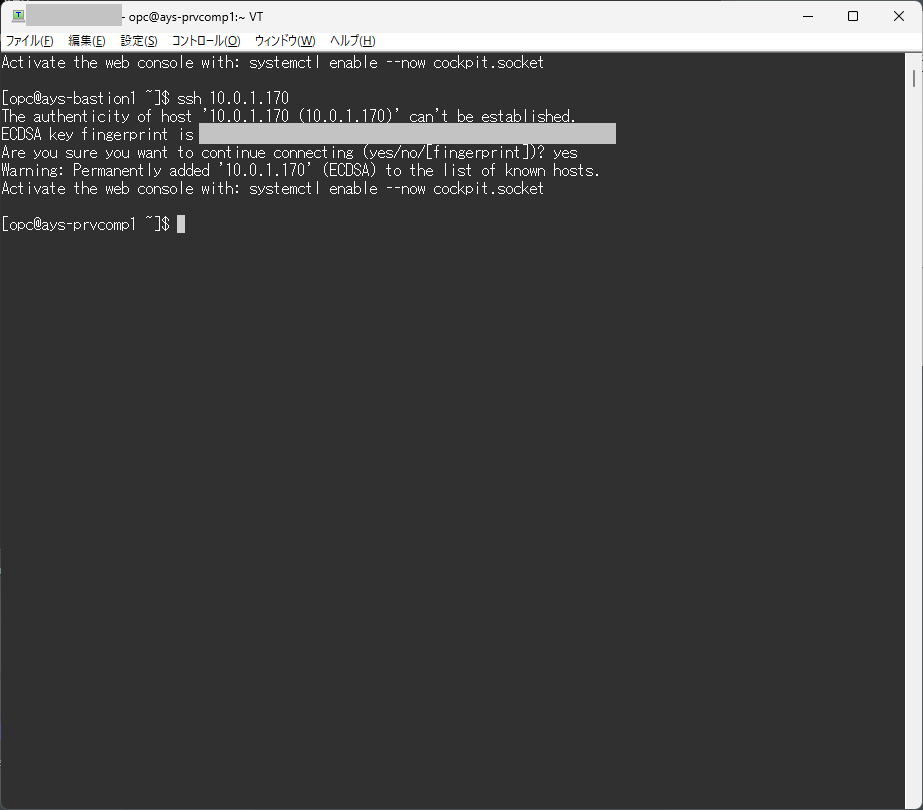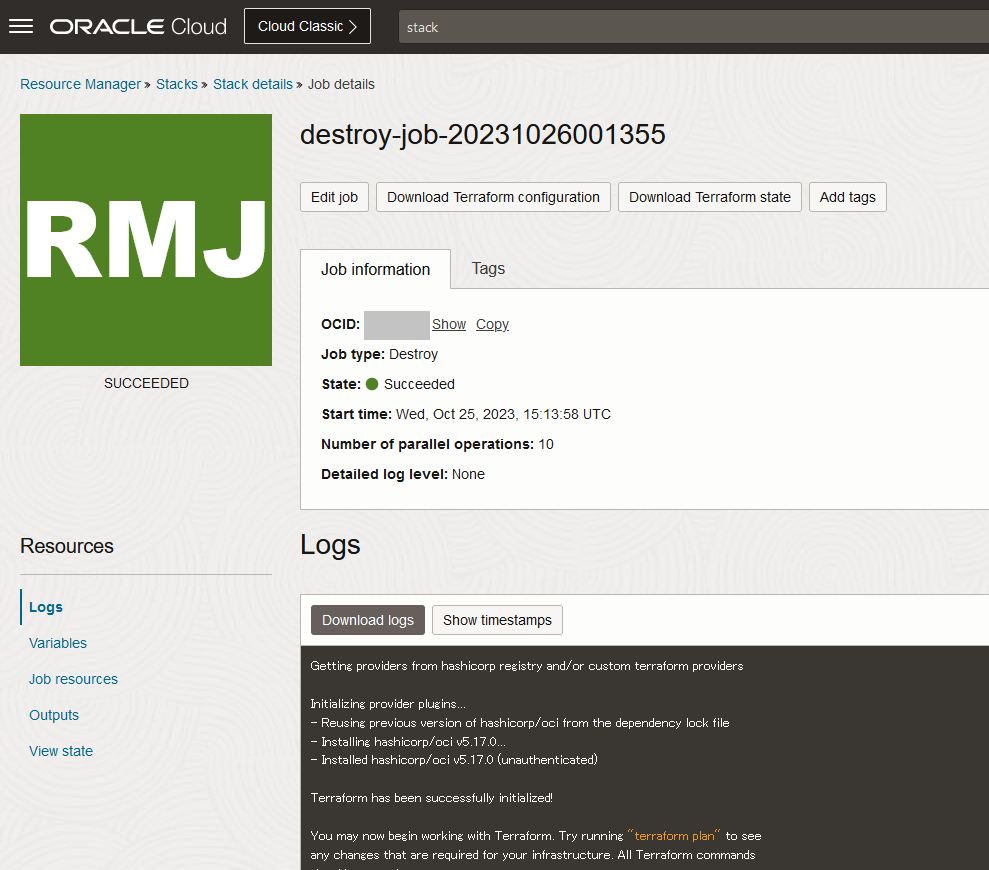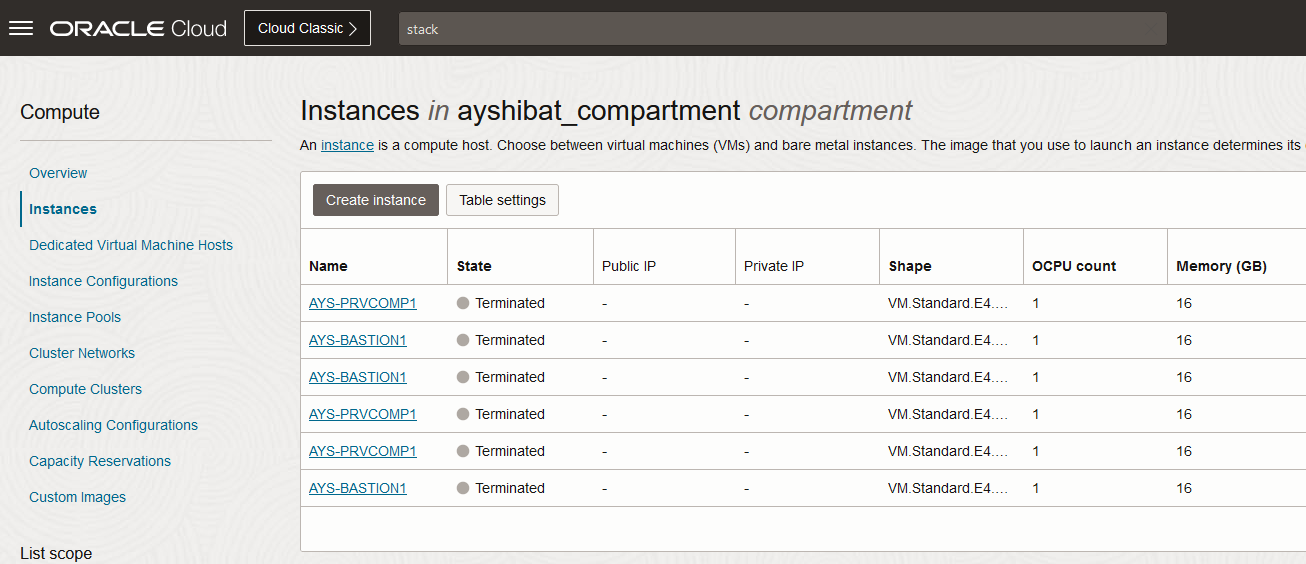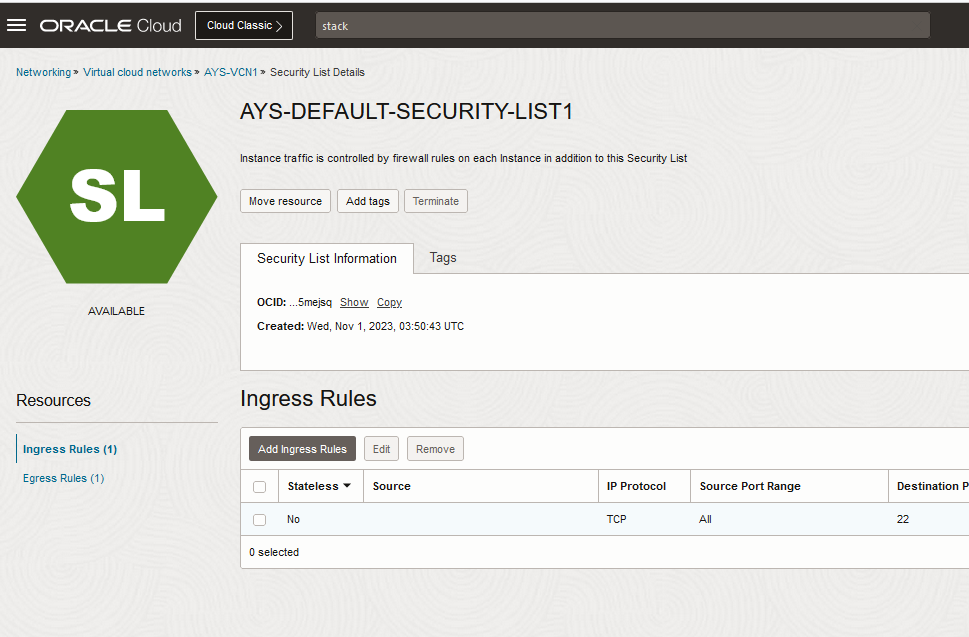OCI の Resource Manager は Terraform の Managed Service となります。
リソース・マネージャの概要
https://docs.oracle.com/ja-jp/iaas/Content/ResourceManager/Concepts/resourcemanager.htm
リソース・マネージャは、Oracle Cloud Infrastructureリソースのプロビジョニング処理を自動化できるOracle Cloud Infrastructureサービスです。Terraformを使用する場合、リソース・マネージャでは、「infrastructure-as-code」モデルを使用してリソースをインストール、構成および管理できます。
手元のOCI環境を再構築する必要があり、かねてからやる必要を感じていた OCI Resource Manager による環境構築を実践してみたやで。
彡(゚)(゚)
1. 構築した環境
下記記事(Terraform)の環境を OCI Resource Manager で再構築してみました。アイコン群がちょっと懐かしい……。
2. GitHub の OCI Resource Managerサンプル
GitHub に OCI Resource Manager のサンプルをアップロードしました。
下記コマンドでリポジトリをクローンして下さい。gitコマンドが使用不可の場合は、上記URLから Codeボタン→Download ZIPして下さい。
git clone https://github.com/gonsuke777/terraform
3つディレクトリが作成されますが、本記事では OCI Resource Manager用 の oci_test_env1_rm を使用します。
3. SSHキーペアの作成と公開鍵の編集
下記マニュアルを参照してSSHキーペアを2つ作成して、それぞれの公開鍵を zzzzzzzz.pub と yyyyyyyy.pub にセットして下さい。ファイル名は変更可能です。ファイル名を変更した場合は後述の vars.tf を編集します。
キー・ペアの作成
https://docs.oracle.com/ja-jp/iaas/Content/GSG/Tasks/creatingkeys.htm
既に利用可能なSSHキーペアを保持している場合は、本作業はスキップして問題ありません。
4. vars.tf の変数を記述
vars.tf の変数を記述します。内容は以下の通りです。
| 変数 | 説明 |
|---|---|
| tenancy_ocid | テナントのOCIDを記述します。 |
| region | リージョン名を記述します。ap-tokyo-1, us-phoenix-1 など |
| compartment_ocid | コンパートメントのOCIDを記述します。 |
| pub_subnet_seclst_ingress_rule | パブリック・サブネットにアクセスする接続元(例:PCなど)のCIDRを記述します。制限しない場合は 0.0.0.0/0 を記述して下さい。 |
| os_image_source_id | Provider OSイメージ(Oracle Linuxなど)のOCIDを記述します。https://docs.cloud.oracle.com/iaas/images/ を参照して下さい。デフォルト値は Oracle Linux 8.8 の TokyoリージョンのイメージOCIDとしています。 |
| public_compute_ssh_key | パブリック・サブネットに作成する Compute の SSH鍵(公開鍵)のファイル名を記述します。 |
| private_compute_ssh_key | プライベート・サブネットに作成する Compute の SSH鍵(公開鍵)のファイル名を記述します。 |
| public_compute_ad_num | パブリック・サブネットに作成する Compute の AD(Availability Domain)番号を指定します。1ADリージョンの場合は 1 のみ指定可能です。 |
| private_compute_ad_num | プライベート・サブネットに作成する Compute の AD(Availability Domain)番号を指定します。1ADリージョンの場合は 1 のみ指定可能です。 |
| oci_resource_prefix | リソース名の接頭辞(プレフィックス)を4文字以内で記述します。 |
# Variables
## Provider Variables
### tenant ocid
variable "tenancy_ocid" {
default = "ocid1.tenancy.oc1..xxxxxxxxxxxxxxxxxxxxxxxxxxxxxxxxxxxxxxxxxxxxxxxxxxxxxxxxxxxx"
}
### OCI region (ex:ap-tokyo-1, us-phoenix-1, etc...)
variable "region" {
default = "ap-tokyo-1"
}
### Compartment OCID
variable "compartment_ocid" {
description = "The compartment which resources will be created"
default = "ocid1.compartment.oc1..xxxxxxxxxxxxxxxxxxxxxxxxxxxxxxxxxxxxxxxxxxxxxxxxxxxxxxxxxxxx"
}
## Networking Variables
### Public Subnet - Security List Ingress Rule
variable "pub_subnet_seclst_ingress_rule" {
description = "Describe the CIDR of the connection source (ex: your PC, etc..). If you want to allow from all networks, describe 0.0.0.0/0."
default = "xxx.xxx.xxx.xxx/xx"
}
## Compute Variables
### Regional OS Image ID, this ID is different for each region. Look https://docs.cloud.oracle.com/iaas/images/
variable "os_image_source_id" {
description = "For OS Image Source ID, look https://docs.cloud.oracle.com/iaas/images/"
default = "ocid1.image.oc1.ap-tokyo-1.aaaaaaaaqgqr35z52xjqh3nxinud7ixdft3dxdsescidrgeh2v5rp6dqfwea"
}
### Compute ssh key path(pub format)
variable "public_compute_ssh_key" {
description = "Public Compute ssh key file (in pub format) path (.../.../<key_filename>)"
default = "./zzzzzzzz.pub"
}
variable "private_compute_ssh_key" {
description = "Private Compute ssh key file (in pub format) path (.../.../<key_filename>)"
default = "./yyyyyyyy.pub"
}
### Compute Availability Domain(1 or 2 or 3)
variable "public_compute_ad_num" {
description = "Public Compute Availability Domain Num(1 or 2 or 3)"
default = "1"
}
variable "private_compute_ad_num" {
description = "Private Compute Availability Domain Num(1 or 2 or 3)"
default = "1"
}
## Resource Prefix
variable "oci_resource_prefix" {
description = "The prefix of all the resources to be created. Maximum 4 characters."
default = "AYS"
}
5. Resource Manager の Stack作成 および plan, apply によるプロビジョニング
OCIコンソールの Resouce Manager Stacks画面に遷移して Stack を作成します。
vars.tf を編集した oci_test_env1_rmディレクトリを Stack にアップロードして下さい。
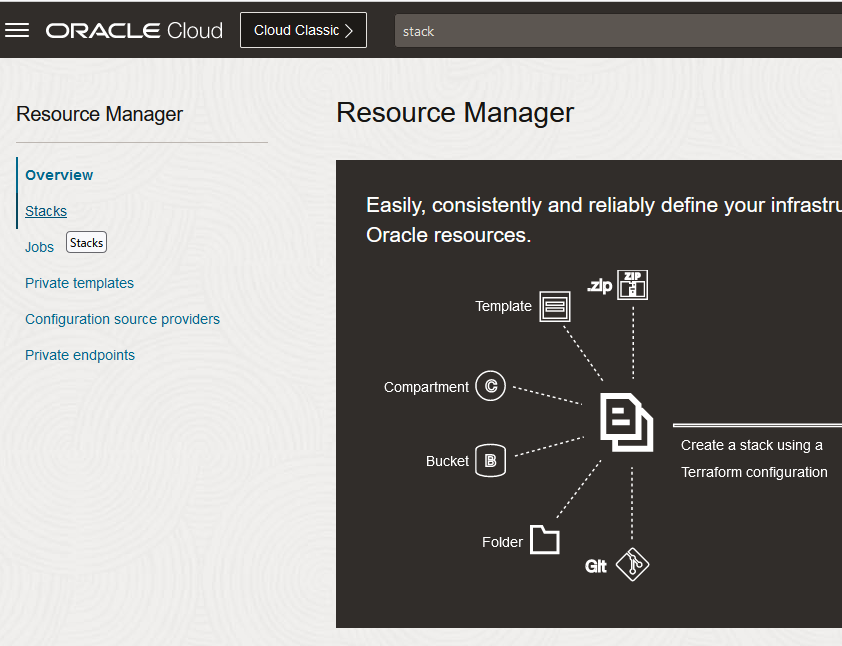
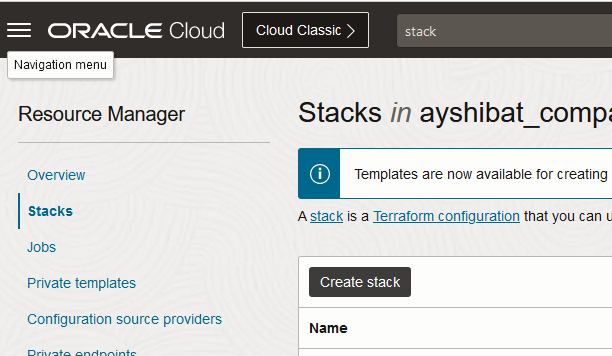
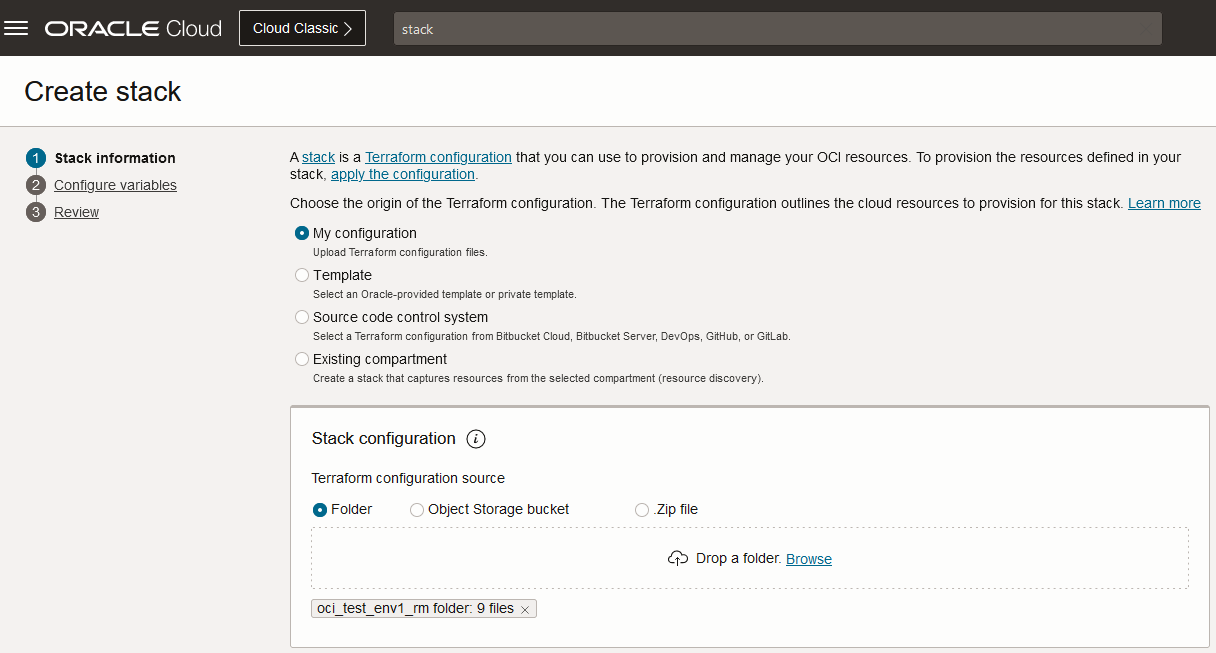
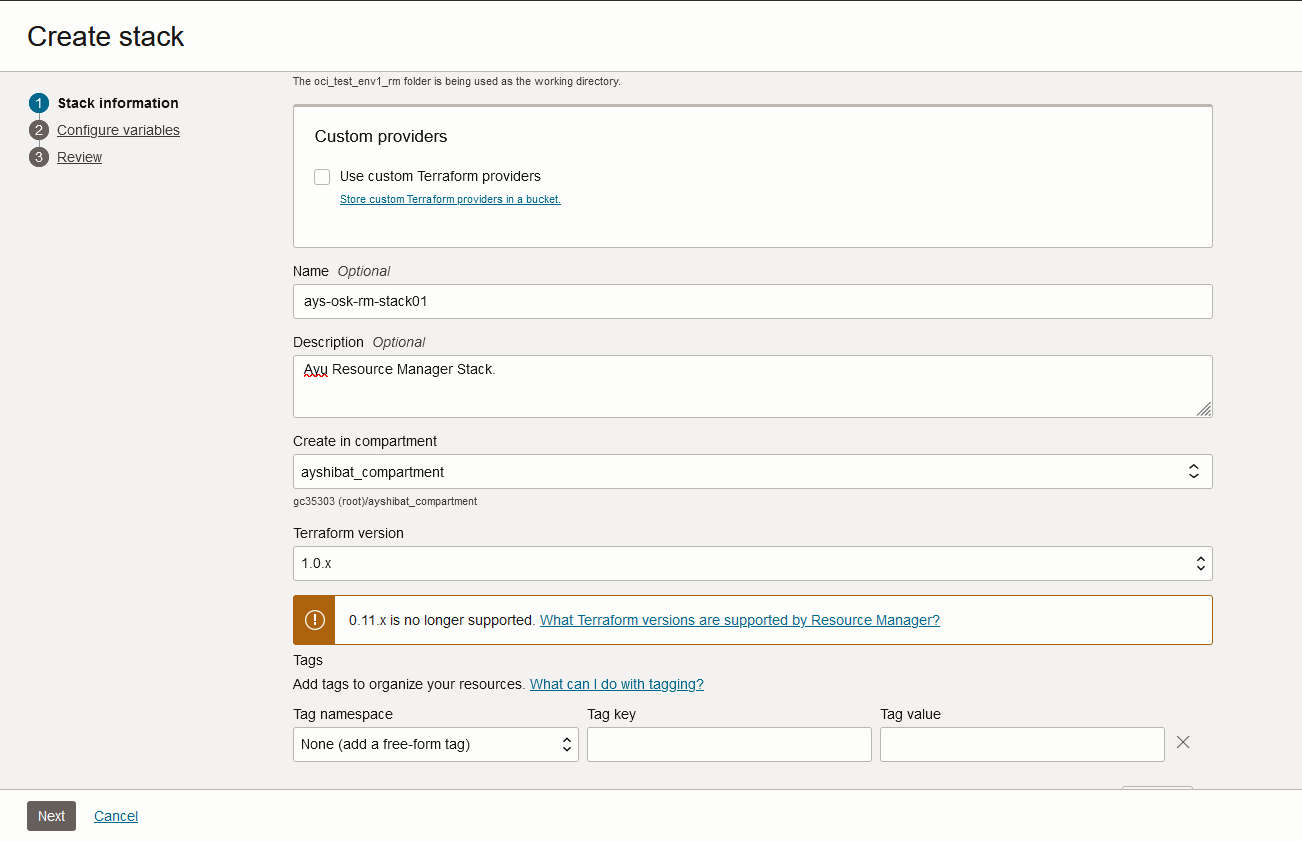
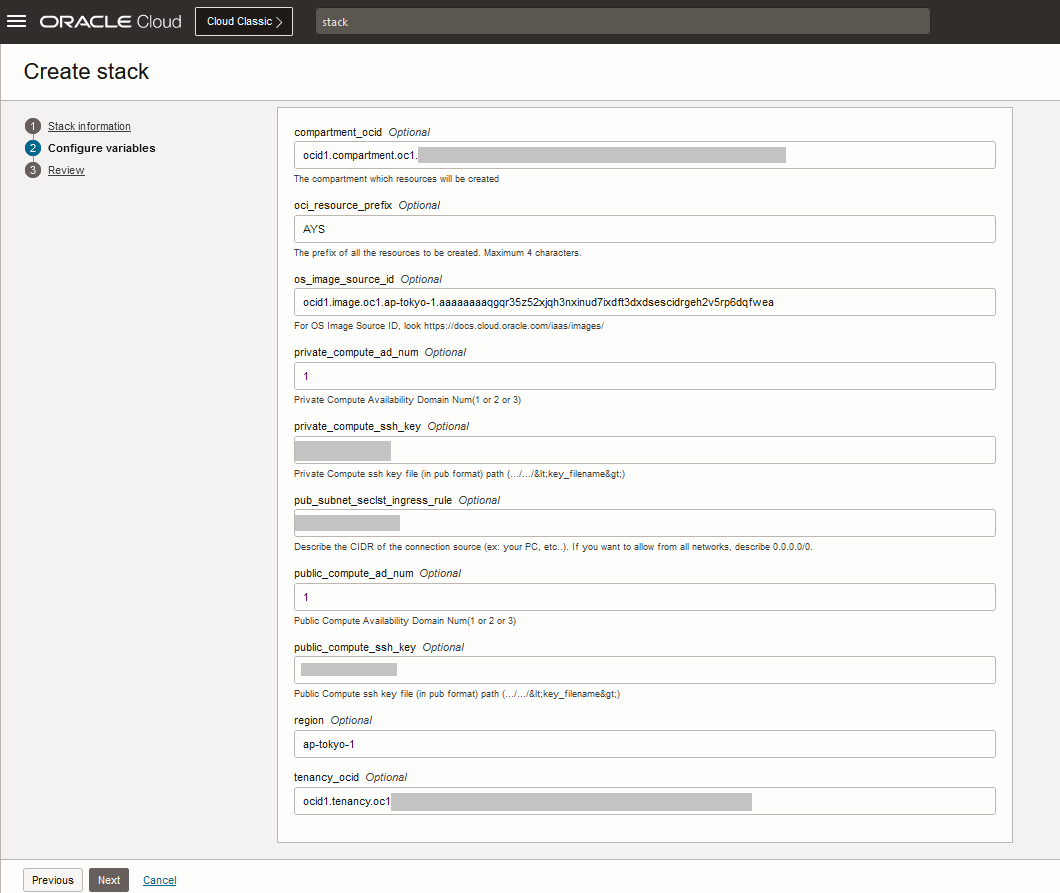
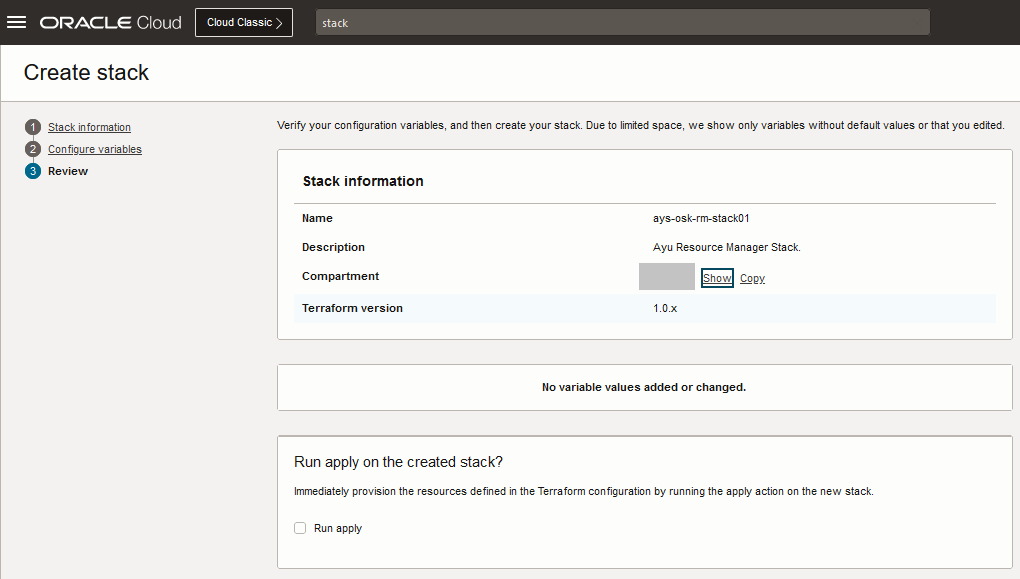
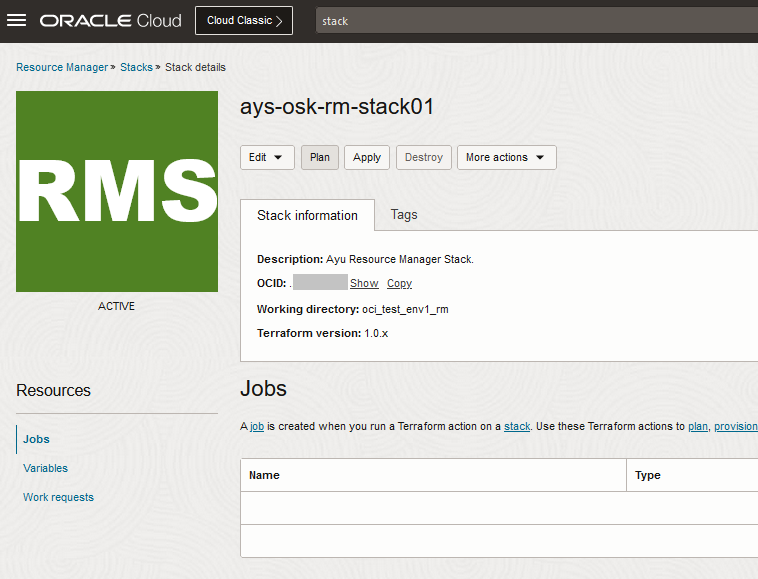
作成した Resource Manager Stack を plan, apply します。
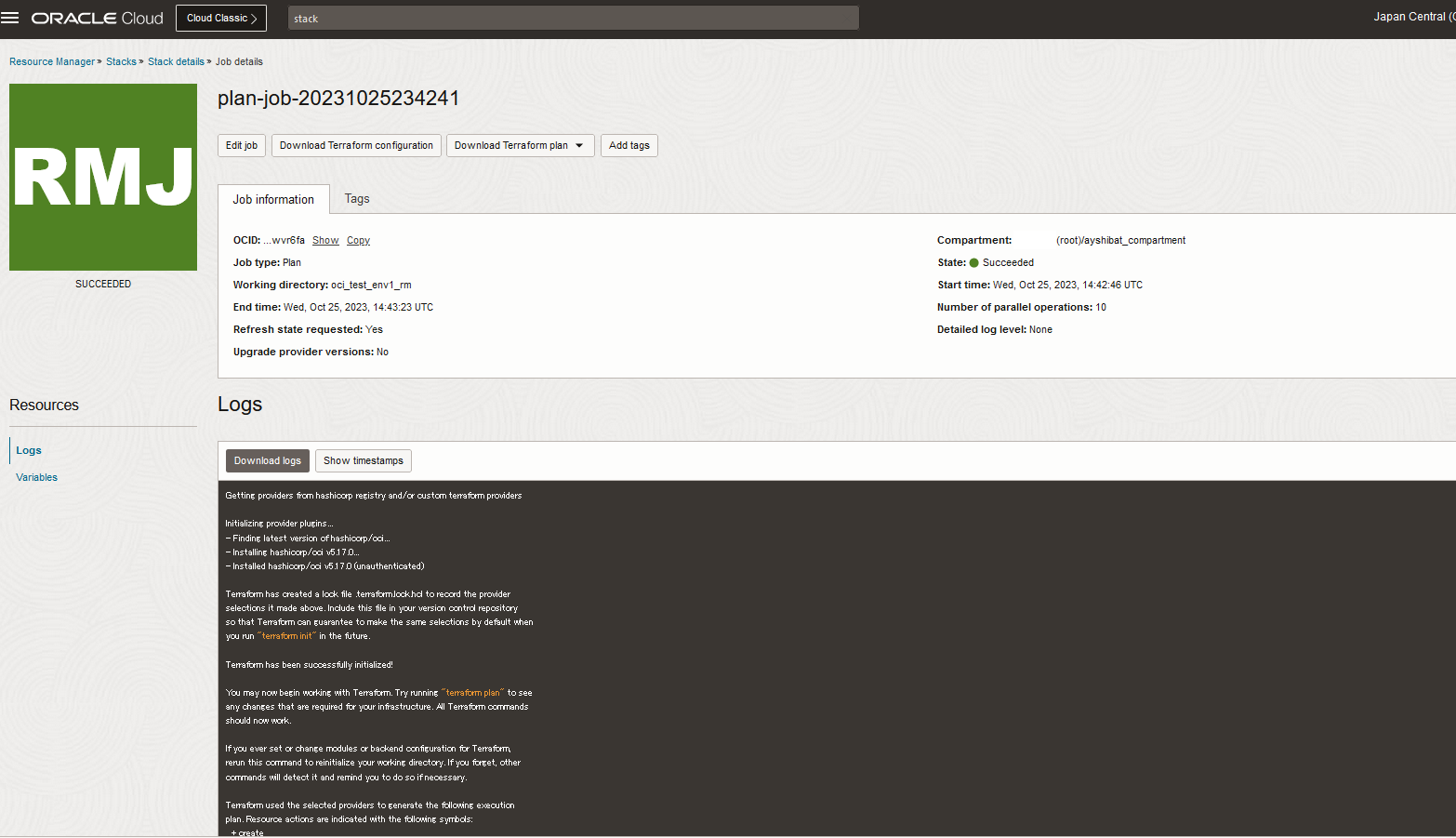
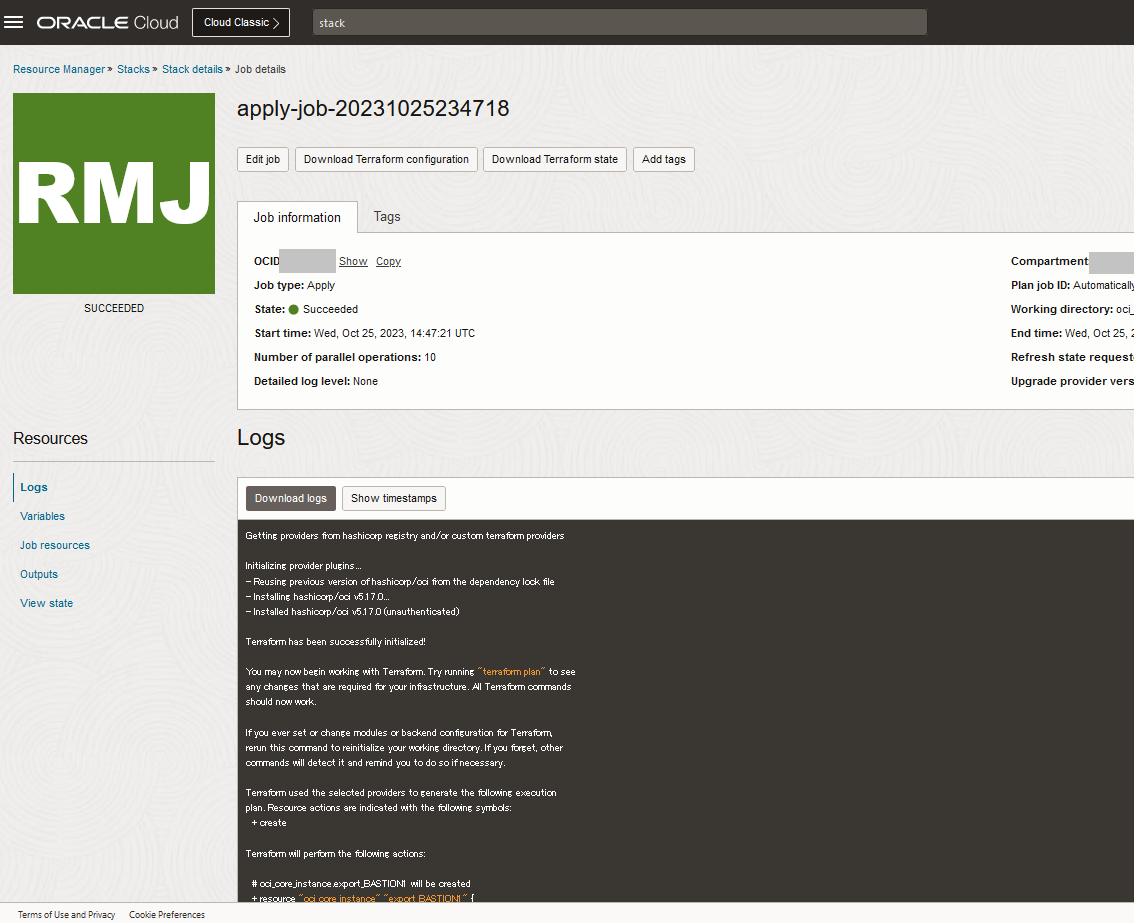
成功しました。Compute も作成されてますやね彡(^)(^)
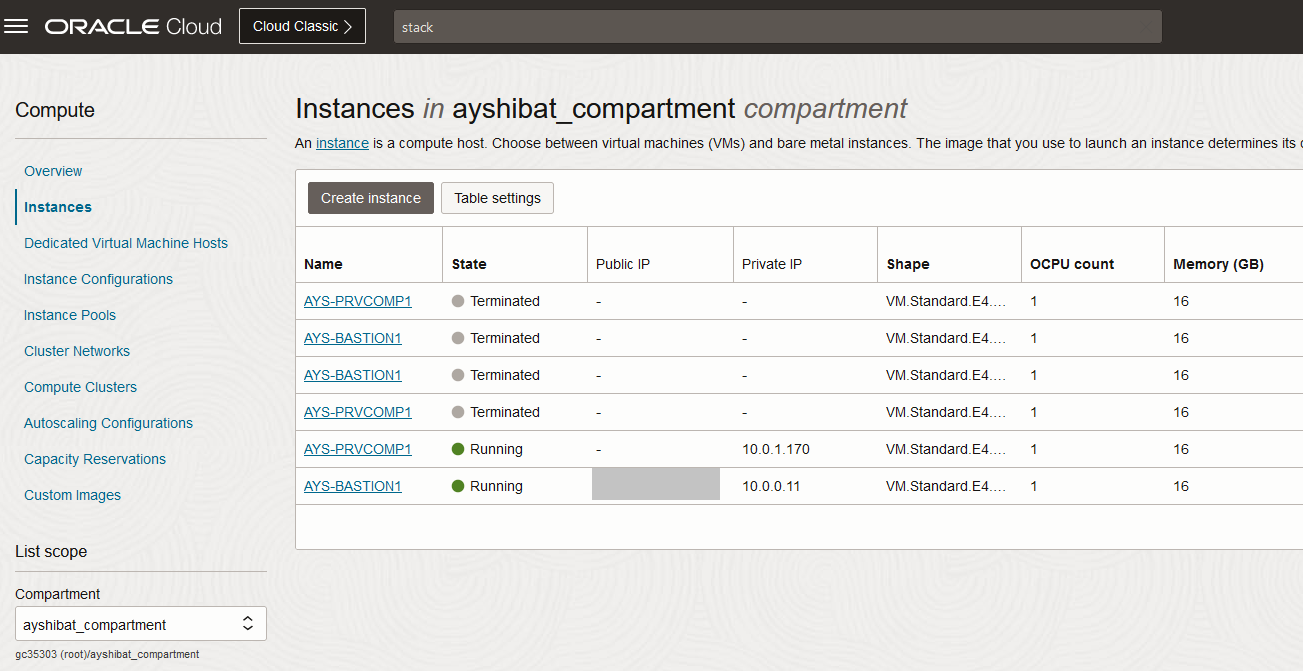
6. 元記事からの変更点
vars.tf および provider.tf の user_ocid, fingerprint, private_key_path は削除しています。
Terraform の場合は Terraform を実行するためのOCIユーザー関連の情報が必要ですが、OCI Resource Manager の場合はOCIコンソールにログインしたOCIユーザーの権限(ポリシー)で実行されるため、これらの情報は不要だからです。
# Terraform Provider
provider "oci" {
tenancy_ocid = "${var.tenancy_ocid}"
user_ocid = "${var.iam_user_ocid}" #削除
fingerprint = "${var.iam_user_fingerprint}" #削除
private_key_path = "${var.iam_user_private_key_path}" #削除
region = "${var.region}"
}
:
### IAM User OCID --削除
variable "iam_user_ocid" {
default = "ocid1.user.oc1..xxxxxxxxxxxxxxxxxxxxxxxxxxxxxxxxxxxxxxxxxxxxxxxxxxxxxxxxxxxxxxxxxxxxx"
}
### API fingerprint of IAM User --削除
variable "iam_user_fingerprint" {
default = "xx:xx:xx:xx:xx:xx:xx:xx:xx:xx:xx:xx:xx:xx:xx:xx"
}
### IAM User private key path(pair of API fingerprint) --削除
variable "iam_user_private_key_path" {
default = "./sshkey/oci-terraform.pem"
}
Compute のシェイプは VM.Standard.E2.1 から VM.Standard.E4.flex に変更しています。
OSイメージが元のシェイプに対応していませんでした。流石にシェイプが古すぎた^q^
:
shape = "VM.Standard.E2.1"
:
↓
:
shape = "VM.Standard.E4.Flex"
shape_config {
memory_in_gbs = "16"
ocpus = "1"
}
:
パブリック・サブネットにアタッチするセキュリティ・リストの Ingress Rule は CIDR を変数として入力するようにしました。0.0.0.0/0 は必要に応じて設定しましょう。
:
ingress_security_rules {
source = "0.0.0.0/0"
source_type = "CIDR_BLOCK"
protocol = "6"
stateless = "false"
tcp_options {
max = "22"
min = "22"
}
}
:
↓
:
ingress_security_rules {
source = "${var.pub_subnet_seclst_ingress_rule}"
source_type = "CIDR_BLOCK"
protocol = "6"
stateless = "false"
tcp_options {
max = "22"
min = "22"
}
}
:
vars.tf に定義した OSイメージ の OCID は Tokyoリージョン Oracle Linux 8.8(x86版) の OCID としています。
:
### Regional OS Image ID, this ID is different for each region. Look https://docs.cloud.oracle.com/iaas/images/
variable "os_image_source_id" {
description = "For OS Image Source ID, look https://docs.cloud.oracle.com/iaas/images/"
default = "ocid1.image.oc1.ap-tokyo-1.aaaaaaaaqgqr35z52xjqh3nxinud7ixdft3dxdsescidrgeh2v5rp6dqfwea"
}
:
7. リソースの削除(Destroy)
Resource Manager の Stack から Destroy を実行すると、該当Stack から作成されたリソースが削除されます。
Destroy でリソースが削除されました。簡単に削除できるのは基本エエんですが、誤削除の危険も有るため要注意です。
個人的な考えとして、データストア系のリソース(OCI の場合は BaseDB, Autonomous Database, ExaDB-D など)は OCI Resource Manager や Terraform では作らない、あるいは Resource Manager や Terraform の実行ユーザーからリソースの削除権限(ポリシー)は剥奪しておいた方が良いと認識しています。
(゚ε゚ )
これは下記マニュアルにも同様の記載があります。Resource Manager Stack の Plan と Apply のジョブのみ許可することで、Destroy のジョブ実行を制限しています。
スタックとジョブの管理
https://docs.oracle.com/ja-jp/iaas/Content/Security/Reference/resourcemanager_security.htm#iam-policies__stacks-jobs
グループが破棄ジョブの実行を明示的に禁止するには、このポリシーを作成します
:
Allow group to manage orm-jobs in tenancy where any {target.job.operation = 'PLAN', target.job.operation = 'APPLY'}
8. まとめ
OCI Resource Manager で各種リソースをプロビジョニングできました。個人的には諸事情で定期的に環境の再構築が発生するため、それが OCI RM化できたのは大きい……。
彡(^)(^)
皆さんどんどん活用して下さいね。
9. 追記(デフォルトのセキュリティ・リストの編集)
デフォルトのセキュリティ・リストでは Ingress Rule が 0.0.0.0/0 で設定されているため、必要に応じて編集/削除して下さい。
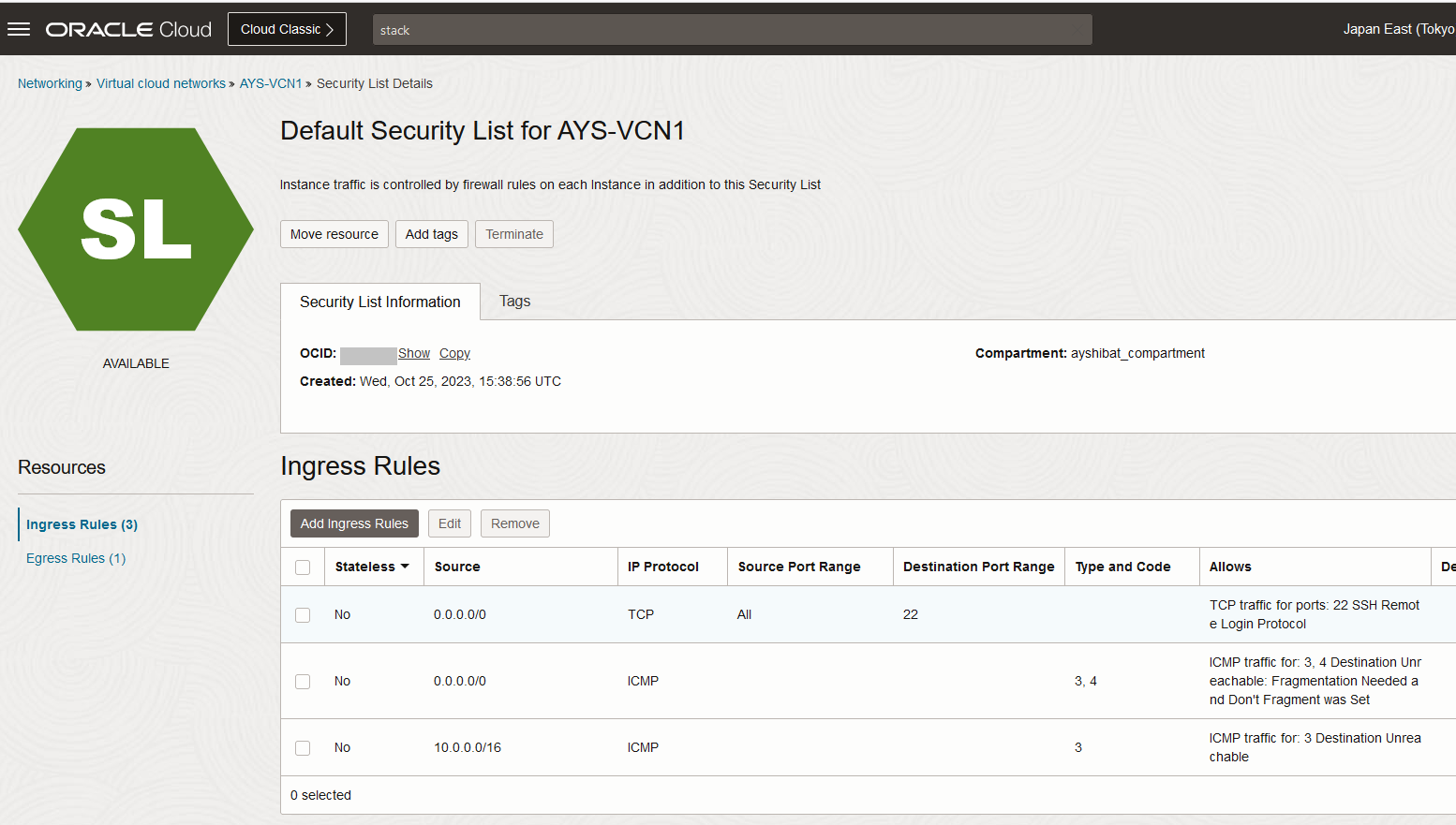
(更に追記)デフォルトのセキュリティ・リストは oci_core_default_security_list で定義できる事が判明したので、Terraform定義に追記しておきました。
:
resource oci_core_default_security_list export_DEFAULT_SECURITY_LIST1 {
manage_default_resource_id = oci_core_vcn.export_VCN1.default_security_list_id
compartment_id = "${var.compartment_ocid}"
display_name = "${upper(var.oci_resource_prefix)}-DEFAULT-SECURITY-LIST1"
egress_security_rules {
destination = "0.0.0.0/0"
destination_type = "CIDR_BLOCK"
protocol = "6"
stateless = "false"
}
ingress_security_rules {
source = "${var.pub_subnet_seclst_ingress_rule}"
source_type = "CIDR_BLOCK"
protocol = "6"
stateless = "false"
tcp_options {
max = "22"
min = "22"
}
}
}
:
本項(oci_core_default_security_list)は下記が参考になります。

